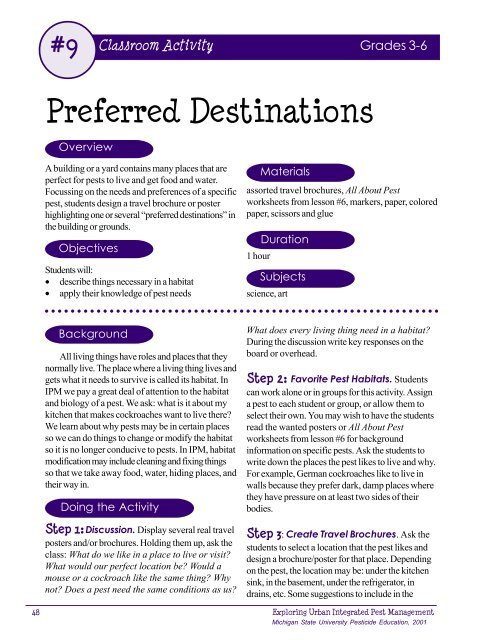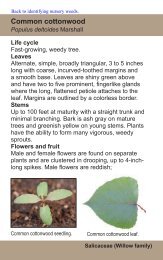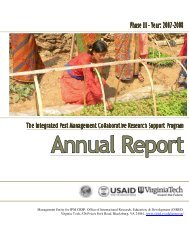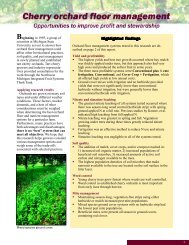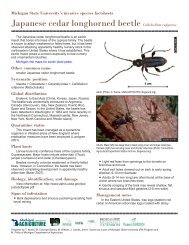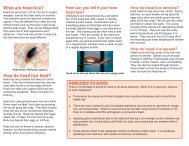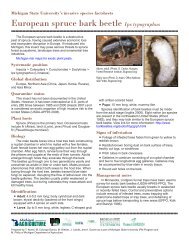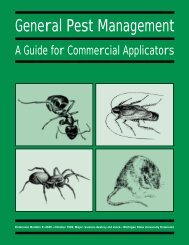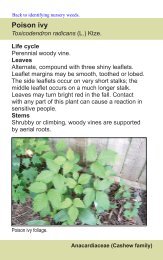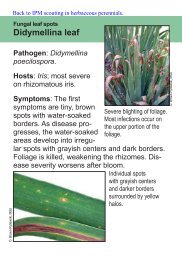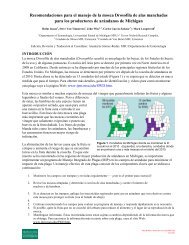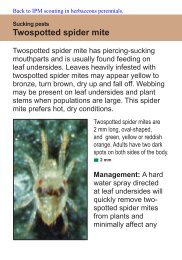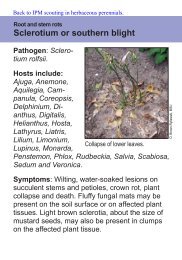Activities and Resources for Teaching K-6 - School Integrated Pest ...
Activities and Resources for Teaching K-6 - School Integrated Pest ...
Activities and Resources for Teaching K-6 - School Integrated Pest ...
Create successful ePaper yourself
Turn your PDF publications into a flip-book with our unique Google optimized e-Paper software.
#9<br />
Classroom Activity Grades 3-6<br />
Preferred Destinations<br />
Overview<br />
A building or a yard contains many places that are<br />
perfect <strong>for</strong> pests to live <strong>and</strong> get food <strong>and</strong> water.<br />
Focussing on the needs <strong>and</strong> preferences of a specific<br />
pest, students design a travel brochure or poster<br />
highlighting one or several “preferred destinations” in<br />
the building or grounds.<br />
Objectives<br />
Students will:<br />
• describe things necessary in a habitat<br />
• apply their knowledge of pest needs<br />
assorted travel brochures, All About <strong>Pest</strong><br />
worksheets from lesson #6, markers, paper, colored<br />
paper, scissors <strong>and</strong> glue<br />
1 hour<br />
Materials<br />
Duration<br />
Subjects<br />
science, art<br />
○ ○ ○ ○ ○ ○ ○ ○ ○ ○ ○ ○ ○ ○ ○ ○ ○ ○ ○ ○ ○ ○ ○ ○ ○ ○ ○ ○ ○ ○ ○ ○ ○ ○ ○ ○ ○ ○ ○ ○ ○ ○ ○ ○ ○ ○ ○ ○ ○ ○ ○ ○ ○ ○ ○ ○ ○ ○ ○ ○ ○<br />
Background<br />
All living things have roles <strong>and</strong> places that they<br />
normally live. The place where a living thing lives <strong>and</strong><br />
gets what it needs to survive is called its habitat. In<br />
IPM we pay a great deal of attention to the habitat<br />
<strong>and</strong> biology of a pest. We ask: what is it about my<br />
kitchen that makes cockroaches want to live there?<br />
We learn about why pests may be in certain places<br />
so we can do things to change or modify the habitat<br />
so it is no longer conducive to pests. In IPM, habitat<br />
modification may include cleaning <strong>and</strong> fixing things<br />
so that we take away food, water, hiding places, <strong>and</strong><br />
their way in.<br />
Doing the Activity<br />
Step 1: Discussion. Display several real travel<br />
posters <strong>and</strong>/or brochures. Holding them up, ask the<br />
class: What do we like in a place to live or visit?<br />
What would our perfect location be? Would a<br />
mouse or a cockroach like the same thing? Why<br />
not? Does a pest need the same conditions as us?<br />
What does every living thing need in a habitat?<br />
During the discussion write key responses on the<br />
board or overhead.<br />
Step 2: Favorite <strong>Pest</strong> Habitats. Students<br />
can work alone or in groups <strong>for</strong> this activity. Assign<br />
a pest to each student or group, or allow them to<br />
select their own. You may wish to have the students<br />
read the wanted posters or All About <strong>Pest</strong><br />
worksheets from lesson #6 <strong>for</strong> background<br />
in<strong>for</strong>mation on specific pests. Ask the students to<br />
write down the places the pest likes to live <strong>and</strong> why.<br />
For example, German cockroaches like to live in<br />
walls because they prefer dark, damp places where<br />
they have pressure on at least two sides of their<br />
bodies.<br />
Step 3: Create Travel Brochures. Ask the<br />
students to select a location that the pest likes <strong>and</strong><br />
design a brochure/poster <strong>for</strong> that place. Depending<br />
on the pest, the location may be: under the kitchen<br />
sink, in the basement, under the refrigerator, in<br />
drains, etc. Some suggestions to include in the<br />
48 Exploring Urban <strong>Integrated</strong> <strong>Pest</strong> Management<br />
Michigan State University <strong>Pest</strong>icide Education, 2001


